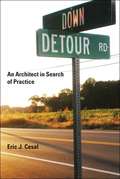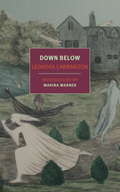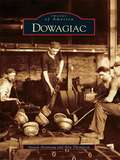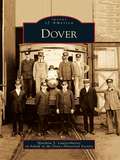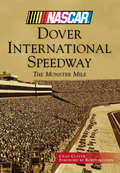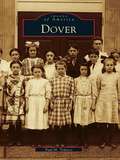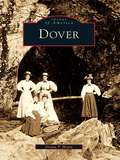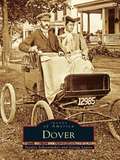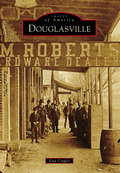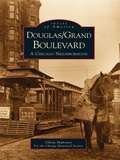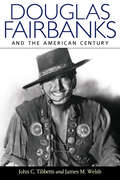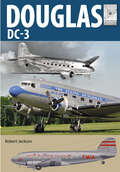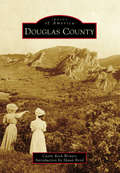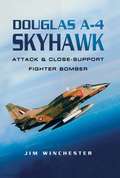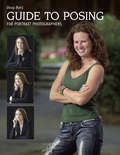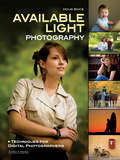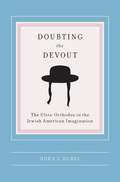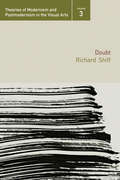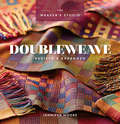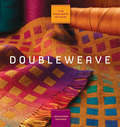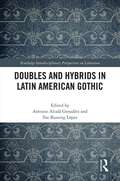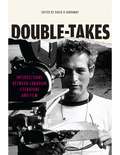- Table View
- List View
Down Detour Road
by Eric J. CesalI paused at the stoop and thought this could be the basis of a good book. The story of a young man who went deep into the bowels of the academy in order to understand architecture and found it had been on his doorstep all along. This had an air of hokeyness about it, but it had been a tough couple of days and I was feeling sentimental about the warm confines of the studio which had unceremoniously discharged me upon the world. --from Down Detour RoadWhat does it say about the value of architecture that as the world faces economic and ecological crises, unprecedented numbers of architects are out of work? This is the question that confronted architect Eric Cesal as he finished graduate school at the onset of the worst financial meltdown in a generation. Down Detour Road is his journey: one that begins off-course, and ends in a hopeful new vision of architecture. Like many architects of his generation, Cesal confronts a cold reality. Architects may assure each other of their own importance, but society has come to view architecture as a luxury it can do without. For Cesal, this recognition becomes an occasion to rethink architecture and its value from the very core. He argues that the times demand a new architecture, an empowered architecture that is useful and relevant. New architectural values emerge as our cultural values shift: from high risks to safe bets, from strong portfolios to strong communities, and from clean lines to clean energy. This is not a book about how to run a firm or a profession; it doesn't predict the future of architectural form or aesthetics. It is a personal story--and in many ways a generational one: a story that follows its author on a winding detour across the country, around the profession, and into a new architectural reality.
Down Below
by Marina Warner Leonora CarringtonA stunning work of memoir and an unforgettable depiction of the brilliance and madness by one of Surrealism's most compelling figuresIn 1937 Leonora Carrington—later to become one of the twentieth century’s great painters of the weird, the alarming, and the wild—was a nineteen-year-old art student in London, beautiful and unapologetically rebellious. At a dinner party, she met the artist Max Ernst. The two fell in love and soon departed to live and paint together in a farmhouse in Provence. In 1940, the invading German army arrested Ernst and sent him to a concentration camp. Carrington suffered a psychotic break. She wept for hours. Her stomach became “the mirror of the earth”—of all worlds in a hostile universe—and she tried to purify the evil by compulsively vomiting. As the Germans neared the south of France, a friend persuaded Carrington to flee to Spain. Facing the approach “of robots, of thoughtless, fleshless beings,” she packed a suitcase that bore on a brass plate the word Revelation. This was only the beginning of a journey into madness that was to end with Carrington confined in a mental institution, overwhelmed not only by her own terrible imaginings but by her doctor’s sadistic course of treatment. In Down Below she describes her ordeal—in which the agonizing and the marvelous were equally combined—with a startling, almost impersonal precision and without a trace of self-pity. Like Daniel Paul Schreber’s Memoirs of My Nervous Illness, Down Below brings the hallucinatory logic of madness home.
Dowagiac
by Ann Thompson Steven ArseneauThe story of Dowagiac's first 100 years may ring familiar to other small cities across the United States. After Dowagiac was established on a railroad line in 1848, new settlers arrived and had the opportunity to establish large-scale factories in the young village. This growth would last for afull century, fueled by the Round Oak Stove Company and other manufacturers in the city. Because of its manufacturing base, immigrants moved to Dowagiac, and the small city enjoyed strong business and manufacturing districts, solid educational institutions, and a vibrant social life. Surrounding lakes provided one venue for entertainment, while downtown Dowagiac offered theaters and fairs. This book documents and celebrates the history of Dowagiac with over 200 photographs from the collection of the Museum at Southwestern Michigan College.
Dover: Proceedings Of The One Hundred And Twenty-fifth Anniversary Of The Incorporation Of The Town Of Dover, Massachusetts, Wednesday, July 7, 1909 (classic Reprint) (Images of America)
by Dover Historical Society Matthew S. LautzenheiserIn 1807, Christian Deardorff and Jesse Slingluff set out for the Ohio frontier. Before leaving, the men laid out the plat of a village that would sit at the banks of the Tuscarawas River. Over the next 10 years as Deardorff toiled away in his bachelor cabin, he held on to the dream of building his vision. The original plat map the two men devised contained 256 lots with land set aside for churches, schools, and a spacious downtown square. Today, over 200 years after Slingluff and Deardorff filed their plat at Zanesville, Dover continues to reflect their vision of a pleasant little town situated on the Tuscarawas River.
Dover International Speedway: The Monster Mile
by Chad Culver Bobby AllisonIn the fertile farmlands of Delaware, there is a monster--a one-mile, concrete oval that has earned a reputation for being one of the toughest NASCAR® tracks since its first race in 1969. Built upon a farmer's field and airstrip, Dover International Speedway has a story filled with dreams and determination. From Richard Petty's first win at the speedway in 1969 through today's modern NASCAR heroes, "The Monster Mile" has witnessed some of racing's most memorable moments and continues to provide some of the best racing in NASCAR to this day. Many rare images have been gathered to provide a never-before-seen look at this historic speedway. Take a journey through time on one of the toughest, fastest, and most unique tracks ever built.
Dover (Images of America)
by Paul H. TedescoOriginally part of the Dedham Grant of 1635, Dover, Massachusetts, became Dedham's Fourth Precinct in 1729 and the Springfield Parish of Dedham in 1748. When the Commonwealth incorporated it in 1836, Dover's economy was based on farming and grazing. Several companies, including the E.F. Hodgson Company and the Harvard Apparatus Company, successfully manufactured portable houses and medical instruments in Dover. However, they eventually left, as Dover remained agriculturally based. By 1896, Dover had become a suburban community. From 1900 to 1914, wealthy Bostonians--many of them members of the Norfolk Hunt Club--built at least eighteen spacious country estates in Dover, far from the noise and hubbub of the city. Population grew slowly after World War I, but in 1945, the town increased in numbers, as veterans returned from World War II and others saw the convenience of commuting to work in Boston while living in a pastoral environment. Once the home of Sen. Leverett Saltonstall, Gov. Francis Sargent, and benefactress Amelia Peabody, Dover today is an elegant country town, a mixture of estates, open fields, forests, and family neighborhoods.
Dover
by Donna P. HearnThrough the years, Dover's landscape has been greatly shaped by the contributions of its many influential residents. Upon his arrival, Richard Sackett, the first English settler in eastern Dutchess County, gazed at the soaring hillsides and gave the town its current name. Dover's most important and pivotal event occurred in 1731, when it hosted representatives at an interstate boundary conference. That indenture signing set the judicial line between the colony of Connecticut and the province of New York. After 1845, the railroad exported iron and brought artists like Asher Durand, whose painting of Dover's plains hangs today in the Smithsonian American Art Museum. With the train came tourists and painters, who were drawn to the sites they saw in Durand's works. In the 20th century, the area changed again as old farms disappeared and new industry moved into town. While the community sent men to war and compassionately housed the mentally ill, the Dover Drag Strip made history as one of the first big drag racing tracks.
Dover
by George Laurie Stanley SchoonmakerWhen Dover was settled in 1722, the only inhabitants of this northern New Jersey wilderness were Native Americans. The early iron forges along the mighty Rockaway River were soon developed, followed by the Morris Canal; it was, however, the coming of the railroad in 1848 that truly transformed the small village. Two hundred and seventy-five years later, Dover is still evolving. In Dover, the town's colorful and diverse past is chronicled through over 200 vintage, many neverbefore-seen photographs, including images of the historic Morris Canal, the majestic churches, theaters, schools, factories, and downtown businesses. See how Blackwell Street looked 100 years ago, and look at sights long gone, such as the Dover speedway, the trolleys, and early automobiles. Most importantly, see the faces of Dover's people, both past and present, that have enriched and molded its past.
Douglasville (Images of America)
by Lisa CooperThe formation of Douglasville coincided when New South ideals were reshaping villages into railroad towns across the South during Reconstruction. In 1875, business and political leaders worked from the ground up to provide Douglasville with each component of a New South town, including a railroad, cotton mill, hotel, bank, and a commercial district. Today, the central business district is listed in the National Register of Historic Places and presents a snapshot regarding how the town fathers actualized their vision of industry and enterprise. Douglasville's founders would be pleased if they visited the town they created 138 years ago. It has entered the 21st century as a vibrant city with a thriving historic district, as well as a destination for businesses ranging from Google to the American Red Cross.
Douglas/Grand Boulevard: A Chicago Neighborhood
by Olivia Mahoney Chicago Historical SocietyThe history of Chicago can be told through its neighborhoods, and perhaps none is more telling than Douglas/Grand Boulevard on the city's south side. The future site of the neighborhood remained a sparsely settled prairie until the early 1850s, when Stephen A. Douglas purchased a large tract of land and began developing a residential subdivision for the wealthy. Douglas/Grand Boulevard: A Chicago Neighborhood explores the development of this distinctive community and the many obstacles its residents encountered. Originally a predominately white neighborhood, Douglas/Grand Boulevard became an African-American community during the Great Migration when thousands of Southern blacks moved north seeking greater opportunities. After the 1919 Race Riot, an increasing number of white residents moved away from the neighborhood, and the community became a national model of black achievement.
Douglas Snelling: Pan-Pacific Modern Design and Architecture (Ashgate Studies in Architecture)
by Davina JacksonDouglas Burrage Snelling (1916–85) was one of Britain’s significant emigré architects and designers. Born in Kent and educated in New Zealand, he became one of Australia’s leading mid-century architects, of luxury residences and commercial buildings, and a trend-setting designer of furniture, interiors and landscapes. This is the first comprehensive study of Snelling’s pan-Pacific life, works and trans-disciplinary significance. It provides a critical examination of this controversial modernist, revealing him to be a colourful and talented protagonist who led antipodean interpretations of American, especially Wrightian and southern Californian, architecture, design and lifestyle innovations.
Douglas Fairbanks and the American Century
by John C. Tibbetts James M. WelshDouglas Fairbanks and the American Century brings to life the most popular movie star of his day, the personification of the Golden Age of Hollywood. At his peak, in the teens and twenties, the swashbuckling adventurer embodied the new American Century of speed, opportunity, and aggressive optimism. The essays and interviews in this volume bring fresh perspectives to his life and work, including analyses of films never before examined. Also published here for the first time in English is a first-hand production account of the making of Fairbanks's last silent film, The Iron Mask,/i>. Fairbanks (1883-1939) was the most vivid and strenuous exponent of the American Century, whose dominant mode after 1900 was the mass marketing of a burgeoning democratic optimism, at home and abroad. During those first decades of the twentieth century, his satiric comedy adventures shadow-boxed with the illusions of class and custom. His characters managed to combine the American Easterner's experience and pretension and the Westerner's promise and expansion. As the masculine personification of the Old World aristocrat and the New World self-made man--tied to tradition yet emancipated from history--he constructed a uniquely American aristocrat striding into a new age and sensibility. This is the most complete account yet written of the film career of Douglas Fairbanks, one of the first great stars of the silent American cinema and one of the original United Artists (comprising Fairbanks, Mary Pickford, Charles Chaplin, and D. W. Griffith). John C. Tibbetts and James M. Welsh's text is especially rich in its coverage of the early years of the star's career from 1915 to 1920 and covers in detail several films previously considered lost.
Douglas Duncan: A Memorial Portrait
by Alan JarvisThis is an unusual memorial to an unusual man. Douglas Duncan was a Torontonian who, by his patronage of the arts, has had an almost incalculable influence on their development in Canada. A bibliophile all his life, he began by espousing bookbinding as his chosen profession and after studying in Paris he returned to Toronto to set up as a bookbinder in 1928. But this was only one part of his life, and while in Paris his interest in music and painting had grown and matured. In 1936 the Picture Loan Society was founded and Duncan, at first one of the Committee, soon became solely responsible for it. It is in this capacity that his influence was greatest: literally hundreds of Canadian artists owe to him, in some measure, a debt of gratitude for sound advice, encouragement, and help generously given. Ten informal essays have been contributed by people who knew Duncan well at different times and at various stages in his career. Because each contributor concentrates on the Douglas Duncan he knew the result is a personal, vivid and immediate portrait of a very attractive man. The book also includes reproductions of paintings by some of the artists whose work Duncan encouraged and collected, and examples of his work as a bookbinder and a photographer.
Douglas DC-3: The Airliner that Revolutionised Air Transport (FlightCraft #21)
by Robert JacksonA guide to the plane that changed commercial aviation: “A whopping 109 color photos shows kits in various stages of completion . . . Enjoyed it.” —Historical Miniatures Gaming SocietyNo airliner in the history of commercial aviation has had a more profound effect than the Douglas DC-3. Reliable and easy to maintain, it carried passengers in greater comfort than ever before.Its origins stem from a design by the Douglas Aircraft Company of Santa Monica, California. Known as the Douglas Commercial One, or DC-1, this new aircraft was revolutionary in concept. It was quickly developed into the DC-2, which led to Douglas’ domination of the domestic air routes of the United States, and of half the world.Experience with the DC-2 led to an improved version, the Douglas Sleeper Transport (DST), first flown on December 17, 1935. This in turn evolved into a 21-seat variant, the DC-3, featuring many improvements. The first American Airlines DC-3 entered service in June 1936, and within three years of its introduction the aircraft accounted for a staggering 95 percent of all US commercial air traffic. From commencement of service to the attack on Pearl Harbor, the DC-3 increased domestic revenue passenger miles more than fivefold. Of the 322 aircraft operated by the country’s airlines in December 1941, 260 were DC-3s. At the pre-war peak, 30 foreign airlines operated the DC-3. On the eve of war, the DC-3’s scheduled flights represented 90 percent of international air traffic.In addition to over 600 civil examples of the DC-3, 10,048 military C-47 variants were built, as well as 4,937 produced under license in the USSR as the Lisunov Li-2 and 487 built by Showa and Nakajima in Japan as the L2D. After the war, thousands of surplus C-47s were converted for civilian use. These aircraft became the standard equipment of almost all the world’s airlines, remaining in frontline service for many years. The ready availability of cheap, easily maintained ex-military C-47s, large and fast by the standards of the day, jump-started the worldwide postwar air transport industry.The full remarkable story of the DC-3, and its ancestor the DC-2, is told in these pages, providing a wealth of information for the modeler and the enthusiast alike.
Douglas County: A Photographic Journey (Images of America)
by Castle Rock Writers Shaun BoydCastle Rock Writers bring readers a collection of vintage images and sketches of Douglas County from approximately 1861 to 1950, covering the settling of towns such as Parker and Sedalia and rural areas like Cherry Valley and Daniel�s Park. Early homesteaders, adventurers, and prospectors journeyed west following the 900-plus miles along the Cherokee Trail, seeking the wealth of gold or needing the curative air of Colorado. On the long and arduous trip, travelers stopped at the Twenty Mile House in Parker or the Pretty Woman Ranch on the First Territorial Road. They needed to clean off the dust and dirt and enjoy a nourishing meal before the final push to Denver and beyond. Some simply stayed. They homesteaded ranches, staked out mines, and built small towns in the rolling plains, mesas, forested hills, and mountains that make up the 843 square miles of Douglas County. In the first half of the 20th century, the region grew into cohesive communities, where families thrived through ingenuity and hard work. Neighbors supported neighbors.
Douglas A-4 Skyhawk: Attack & Close-Support Fighter Bomber
by Jim WinchesterA detailed look at the combat aircraft designed by the legendary Edward H. Heinemann with one role in mind: tactical nuclear delivery. The Skyhawk first entered service with the US Navy almost 50 years ago. It is still in service with various US units and remains the backbone of many of the air forces of those countries to which it has been exported. &“Heinemann&’s Hot Rod&” was never called upon for its original purpose—nuclear delivery from aircraft carriers—but its well-designed airframe proved adaptable to many other uses. This is an in-depth look at the design, production, evolution, operation and performance of the aircraft. It will also include first-hand accounts of flying the Skyhawk in action.
Doug Box's Guide to Posing for Portrait Photographers
by Douglas Allen BoxOften overshadowed by complicated lighting techniques or advanced postproduction tips, this resource seeks to remind the professional photographer of the fundamental importance of a subject's pose. Conveniently designed in two-page spreads-a striking portrait on one side, a comprehensive how-to of the strategies used on the other-this reference includes countless techniques for studio sessions as well as outdoor and location shoots, with individuals or groups, male or female clients, and in sitting, standing, or lying poses. With advice from a well-known and respected professional, it covers all the basics, showing how to emphasize a client's assets and downplay perceived flaws, how to create a cohesive, engaging group photo, how to use natural elements on location to enhance an image, and how to ensure that the result flatters the subject and adds the essential professional polish to an image.
Doug Box's Available Light Photography
by Doug BoxCovering every aspect of creating portraits in available light, acclaimed professional photographer Doug Box provides tips for finding great natural light, practical approaches for optimizing exposure, and techniques for posing subjects for the most flattering effects. For those situations when "perfect" available light can't be found, readers are shown how to modify ambient light to suit their purposes-or give it a bump in intensity with a little pop of flash. Additional topics touched upon include proper lens selection, calculating exposure, managing ambient light both indoors and out, shooting at night, and more. A discussion of applying the many techniques to nature and wildlife, travel, and sports photography rounds out this all-encompassing guide to working with available light.
Doug Box's Available Light Photography
by Doug BoxCovering every aspect of creating portraits in available light, acclaimed professional photographer Doug Box provides tips for finding great natural light, practical approaches for optimizing exposure, and techniques for posing subjects for the most flattering effects. For those situations when "perfect" available light can't be found, readers are shown how to modify ambient light to suit their purposes-or give it a bump in intensity with a little pop of flash. Additional topics touched upon include proper lens selection, calculating exposure, managing ambient light both indoors and out, shooting at night, and more. A discussion of applying the many techniques to nature and wildlife, travel, and sports photography rounds out this all-encompassing guide to working with available light.
Doubting the Devout: The Ultra-Orthodox in the Jewish American Imagination (Religion and American Culture)
by Nora L RubelBefore 1985, depictions of ultra-Orthodox Jews in popular American culture were rare, and if they did appear, in films such as Fiddler on the Roof or within the novels of Chaim Potok, they evoked a nostalgic vision of Old World tradition. Yet the ordination of women into positions of religious leadership and other controversial issues have sparked an increasingly visible and voluble culture war between America's ultra-Orthodox and non-Orthodox Jews, one that has found a particularly creative voice in literature, media, and film.Unpacking the work of Allegra Goodman, Tova Mirvis, Pearl Abraham, Erich Segal, Anne Roiphe, and others, as well as television shows and films such as A Price Above Rubies, Nora L. Rubel investigates the choices non-haredi Jews have made as they represent the character and characters of ultra-Orthodox Jews. In these artistic and aesthetic acts, Rubel recasts the war over gender and family and the anxieties over acculturation, Americanization, and continuity. More than just a study of Jewishness and Jewish self-consciousness, Doubting the Devout will speak to any reader who has struggled to balance religion, family, and culture.
Doubt (Theories of Modernism and Postmodernism in the Visual Arts)
by Richard ShiffIn an age where art history’s questions are now expected to receive answers, Richard Shiff presents a challenging alternative. In this essential new addition to James Elkins’s series Theories of Modernism and Postmodernism in the Visual Arts, Richard Shiff embraces doubt as a critical tool and asks how particular histories of art have come to be. Shiff’s turn to doubt is not a retreat to relativism, but rather an insistence on clear thinking about art. In particular, Shiff takes issue with the style of self-referential art writing seemingly 'licensed' by Roland Barthes. With an introduction by Rosie Bennett, Doubt is a study of the tension between practicing art and practicing criticism.
Doubleweave Revised & Expanded (The Weaver's Studio)
by Jennifer MooreConventional shaft loom weaving constricts the weaver into making only a single layer of fabric that is no wider than the loom. Increase your loom's capabilities with Doubleweave Revised & Expanded! In this comprehensive guide to doubleweave, master-weaver Jennifer Moore revisits the tips and techniques to weaving in multiple layers. Doubleweave Revised & Expanded is filled with new information about doubleweaving and more including: • More doubleweave technique samples for both 4 and 8-shaft looms, including more overshot patterns. • Expanded information on how to weave fabric twice, thrice or even four-times the width of your loom, with no seam. • Beautiful doubleweave project patterns for the home and more! Expand the abilities of your loom with Doubleweave Revised & Expanded!
Doubleweave (The\weaver's Studio Ser.)
by Jennifer MooreDefy Your Loom's Limits!The conventional use for a shaft loom is to weave one layer of flat fabric, no wider than the loom. Doubleweave blows that convention out of the water. Master weaver Jennifer Moore takes a fresh and logical look at this most intriguing of weave structures while exploring its myriad possibilities. Inside you'll learn how to: Weave a fabric twice, thrice, or four times the width of your loom - with no seam Weave a fabric with intersecting layers Change the tie-up to get many structures on one warp Weave stitched, quilted, and piqué fabricsMake color magic with doubleweave blocks Pick up an infinity of patterns in a variety of structures Weave pockets, a seamless tube, many seamless tubes, a tube within a tube And so much more! With Doubleweave, you'll learn to set up your loom efficiently, to manage your shuttles and layer changes, and to finish your work effectively. Best of all, you'll learn to think in a new way about how doubleweave works on as many shafts as you have so you can apply it in fresh and creative ways. You will be a master of the magic of doubleweave.
Doubles and Hybrids in Latin American Gothic (Routledge Interdisciplinary Perspectives on Literature)
by Antonio Alcalá González Ilse Bussing LópezDoubles and Hybrids in Latin American Gothic focuses on a recurrent motif that is fundamental in the Gothic—the double. This volume explores how this ancient notion acquires tremendous force in a region, Latin America, which is itself defined by duplicity (indigenous/European, autochthonous religions/Catholic). Despite this duplicity and at the same time because of it, this region has also generated "mestizaje," or forms resulting from racial mixing and hybridity. This collection, then, aims to contribute to the current discussion about the Gothic in Latin America by examining the doubles and hybrid forms that result from the violent yet culturally fertile process of colonization that took place in the area.
Double-Takes: Intersections between Canadian Literature and Film (Reappraisals: Canadian Writers)
by David R. JarrawayOver the past forty years, Canadian literature has found its way to the silver screen with increasing regularity. Beginning with the adaptation of Margaret Laurence’s A Jest of God to the Hollywood film Rachel, Rachel in 1966, Canadian writing would appear to have found a doubly successful life for itself at the movies: from the critically acclaimed Kamouraska and The Apprenticeship of Duddy Kravitz in the 1970s through to the award-winning Love and Human Remains and The English Patient in the 1990s. With the more recent notoriety surrounding the Oscar-nominated Away from Her, and the screen appearances of The Stone Angel and Fugitive Pieces, this seems like an appropriate time for a collection of essays to reflect on the intersection between literary publication in Canada, and its various screen transformations. This volume discusses and debates several double-edged issues: the extent to which the literary artefact extends its artfulness to the film artefact, the degree to which literary communities stand to gain (or lose) in contact with film communities, and perhaps most of all, the measure by which a viable relation between fiction and film can be said to exist in Canada, and where that double-life precisely manifests itself, if at all. - This book is published in English.
